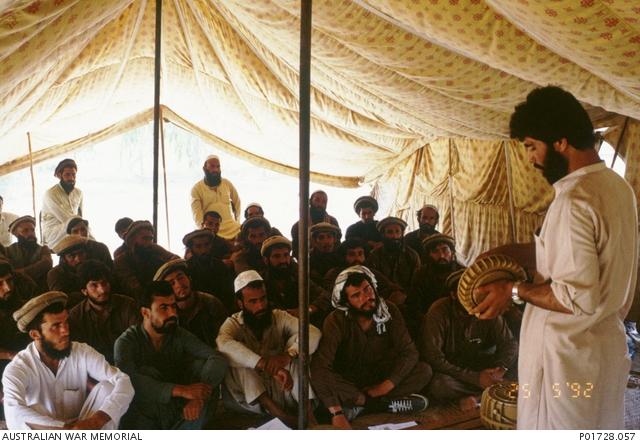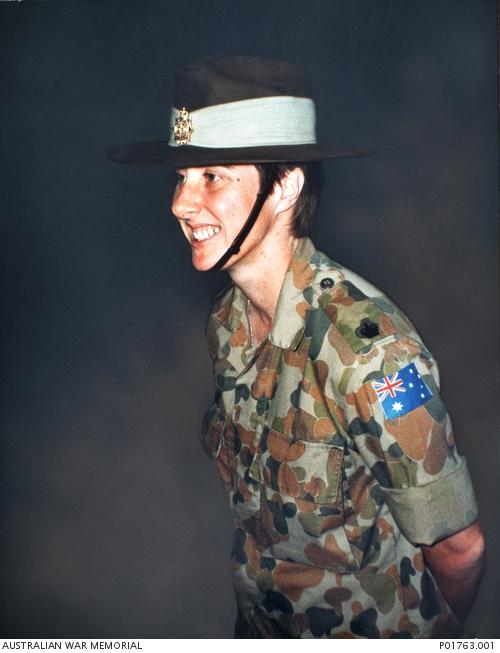Faces of Australian peacekeeping
A new Australian War Memorial travelling exhibition, Keeping the peace: stories of Australian peacekeepers, sets out to bring the history of Australia's forty-odd peacekeeping operations to life.
In a house in Hebron, an Australian soldier sips tea with his Arab hosts; in an Afghan minefield another watches anxiously as men he has trained prod for mines with a bayonet; a doctor tends the victims of a massacre at a Rwandan refugee camp; a policeman makes friends with local children in Haiti.
What is the common thread here? In all these places, societies have been torn apart by war or by violent internal conflict. Innocent people have died, and may still be dying, even as the society starts to mend itself. And in every case Australians have come as peacekeepers, not with a quick fix to the problems, but with the ability to soothe and to heal, to provide a presence which shows that the conflict is not forgotten by the wider international community.
Australian peacekeeping has a long and honourable history. Our first peacekeepers - indeed, the first United Nations peacekeepers - were military observers sent to Indonesia in September 1947; their story was told in Wartime 1. Since then, there have always been Australian peacekeepers in the field, helping in the aftermath of about 25 different wars or conflicts.
The situations in which these peacekeepers found themselves have often been almost unimaginable when compared with the comfort and security of life in Australia. Rwanda is probably the extreme example: before Australians joined a UN operation there in 1994, about half-a-million Rwandans had died in a horrific, genocidal blood-letting. In Cambodia, at least a fifth of the population had been killed under the Pol Pot regime, while in Somalia, famine was compounded by factional violence.
Though only ten Australian peacekeepers have died, the task is always potentially one of danger. On a winter's day in southern Lebanon, in 1988, two UN observers, an Australian and a Canadian, drove up a hill to have a look over the surrounding countryside. From the top they could look west over the Mediterranean, north of Tyre, and south to the Israeli border. On the way up they had a close shave, being forced off the road by an Israeli armoured personnel carrier. On the way down they were less lucky. Their jeep was blown up by a landmine - which they must have narrowly missed on the way up - and the Australian, Captain Peter McCarthy, was killed. The Canadian was seriously injured.
The RSL ANZAC Peace Medal that was awarded posthumously to McCarthy forms part of the new exhibition. He was not the first Australian peacekeeper to fall victim to a landmine. In 1974 a policeman, Sergeant Ian Ward, was killed by a mine in Cyprus while he was driving a Turkish Cypriot family across the buffer zone west of Nicosia. He had only been on the island for five days.
Landmines are indeed one of the great scourges of the modern age. Cheap to manufacture, easy to lay, and hard to find again afterwards, they lie in wait on many of the world's former battlefields, still ready to deprive the unwary child or adult of limbs, eyes, or life itself. The injuries can be horrific. Australian Captain Marcus Fielding wrote home to his wife, describing the injuries suffered by a local de-miner in Afghanistan:
the blast forced the bayonet he was prodding with through the top of his head. He's missing the front of his skull, eyes and his brain is exposed and damaged. The doctors at the Red Cross hospital here in Peshawar are amazed he survived and is still alive two weeks later.
The man died soon afterwards

Pakistani and Afghan mine clearing personnel listen to a lecture, Pakistan, 1992. C266085
De-mining is but one of the many forms of specialist contribution Australians have made to peacekeeping operations. Signallers have served in Western Sahara and Cambodia, engineers in Namibia, weapons inspectors in Iraq. Civilian police have helped build confidence in local structures for law and order, trained police, built gaols, even on one occasion written a law code. The RAN and RAAF have sometimes contributed ships and aircraft; for many other missions they have provided personnel who have served alongside those from the army.
The exhibition displays the UN beret of Army doctor Major Susan Felsche, who served in Western Sahara in 1993. In June that year she was stationed in a camp near Awsard. The camp consisted of weatherhaven shelters "surrounded by a stone wall and a row of rocks marking the distant perimeter. Beyond that is out of bounds." From there, Felsche would fly to visit sick and injured members of the peacekeeping force and to conduct clinics for local people. But on 21 June her Pilatus Porter aircraft crashed on takeoff, killing the pilot, Felsche, and another crew member.

Major Susan Felsche about to depart for Western Sahara. C268976
Another woman Army doctor, Captain Carol Vaughan-Evans, was at the centre of one of the most horrific situations ever experienced by Australian soldiers. In April 1995 she was posted with a small group of soldiers at Kibeho refugee camp in Rwanda. Tensions at the camp were high between the forces of the government, now Tutsi-led, the predominantly Hutu refugees, and Hutu militia sheltering amongst the refugees. The result was a massacre, in which several thousands died. The Australians, along with a larger force of Zambian peacekeepers also at the camp, could only witness the tragedy, and do what they could to help the wounded. By chance, artist George Gittoes was present, and described the scene:
We didn't have any APCs to get us out, for us to take cover in, so when the actual fighting began there was no cover at all. So people like Carol Vaughan-Evans heroically stitched up [the] wounded, with bullets flying all around them - there was no safe position, they just worked in the open.
Gittoes' drawing, Captain Carol-Vaughan-Evans, documents the scene.
The exhibition does not neglect our largest ever peacekeeping operation, that in East Timor. As well as works by official artists Rick Amor and Wendy Sharpe, it includes a newly-commissioned portrait of Interfet commander, Major General Peter Cosgrove. The common soldier is also represented. For example, the exhibition includes a quilt made by family members of soldiers in one of the battalions serving in East Timor, 5th/7th Battalion, Royal Australian Regiment (5/7RAR). Each family contributed a patch of cloth to represent a husband, brother, son, or friend; a committee added patches for soldiers whose families did not respond. (For an account of 5/7RAR's experiences in East Timor, see Wartime 10.)
The work of a peacekeeper can never be done in isolation from the people the operation is supposed to be serving. Sometimes contact will be brusque, to say the least: disarming militia in Somalia or East Timor, or boarding merchant ships in the Persian Gulf to inspect their cargoes. But Australian peacekeepers have shown a great ability to build relationships with the local population - by patrolling on foot, by helping schools and orphanages, and above all by being willing to talk.
A toy helicopter in the exhibition exemplifies this trait. It was made for Bob Sobey, of the Australian Federal Police, by children in Haiti in 1994. The children modelled it on the Chinooks used in the operation. They made it for money (and Sobey duly paid them), but they also did it because Sobey had, in a few months, become part of their community. When Sobey later served on East Timor he had a rule for his police that they must drive around with their car windows down, to minimise the barriers between them and the East Timorese.
Peacekeeping is never easy, of course, and some problems have proved intractable: Australian peacekeepers were in Kashmir for 35 years, and have now been in the Middle East and Cyprus for even longer. Peacekeepers in these conflicts will always occupy a difficult position in the middle, as illustrated in George Gittoes' quintessential painting of Australian peacekeeping, A plea for peacekeepers. The observer sits among a family that has lost several members in a massacre at Hebron. They seek UN support, but whatever his sympathies the observer must remain a neutral, unsuborned, uncorrupted but not out of touch. It is a role at which Australians have proved adept for over half a century.

George Gittoes, A plea for peacekeepers. ART91481
Keeping the peace: stories of Australian peacekeepers is on display in the Special Exhibitions Gallery at the Australian War Memorial until 2 December 2001, when it will begin to tour nationally. For more information, go to our website.